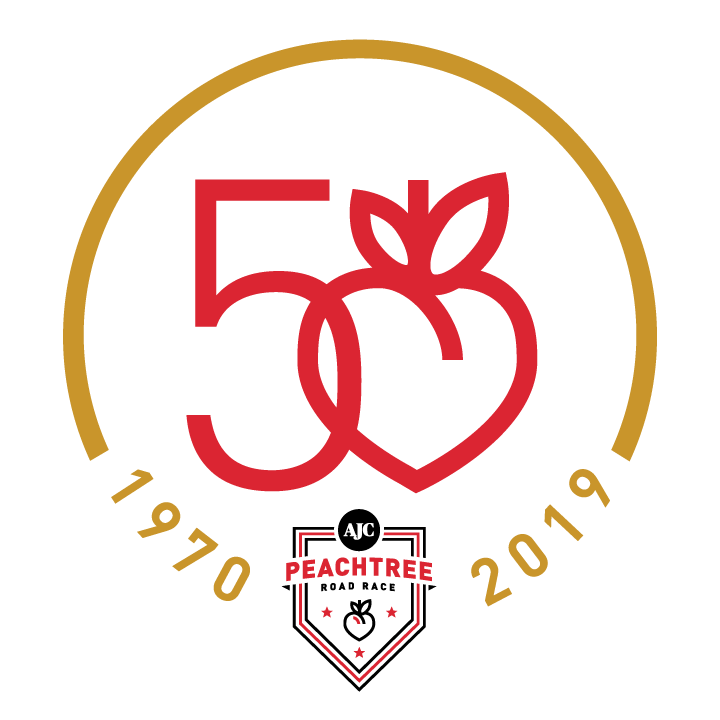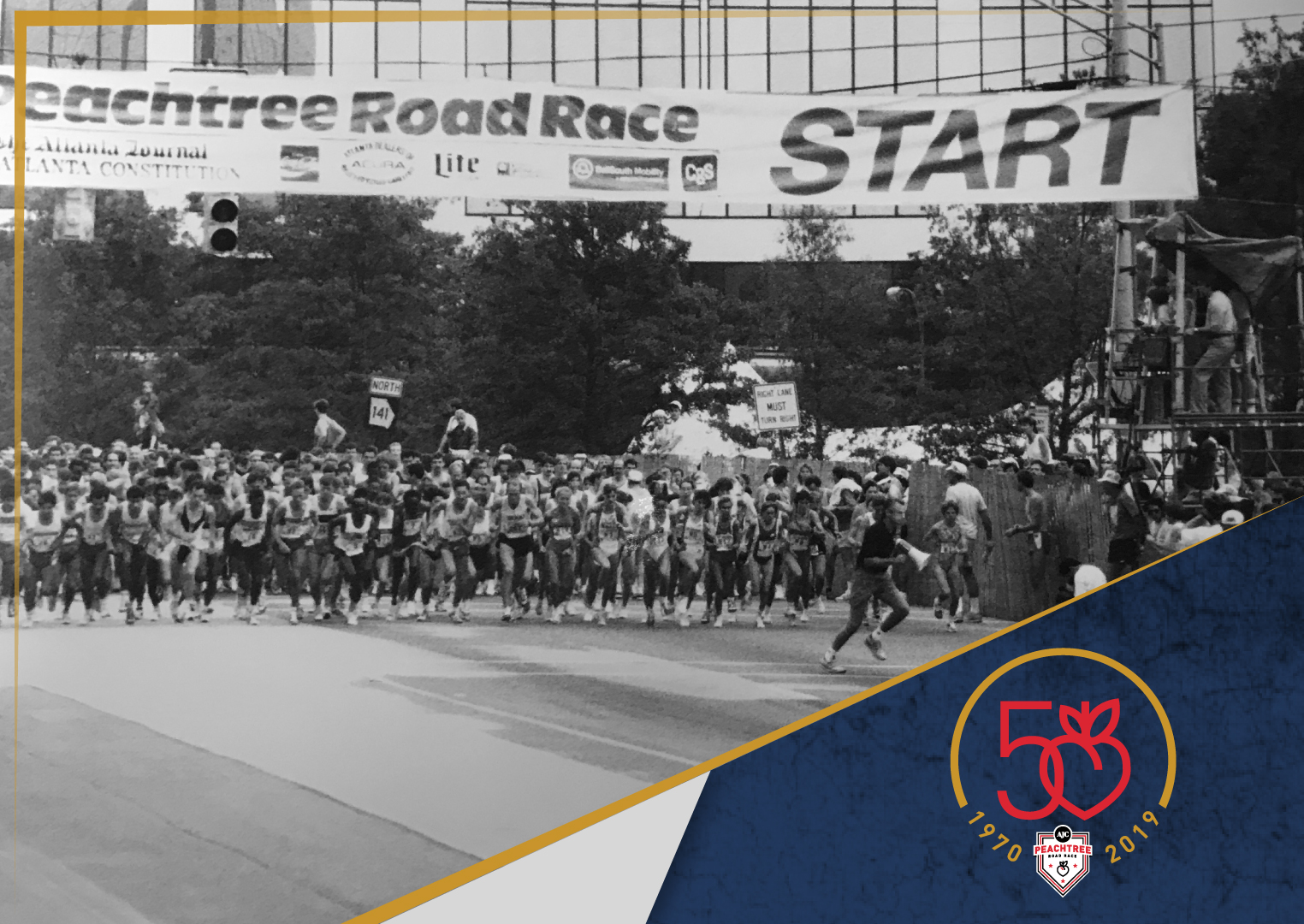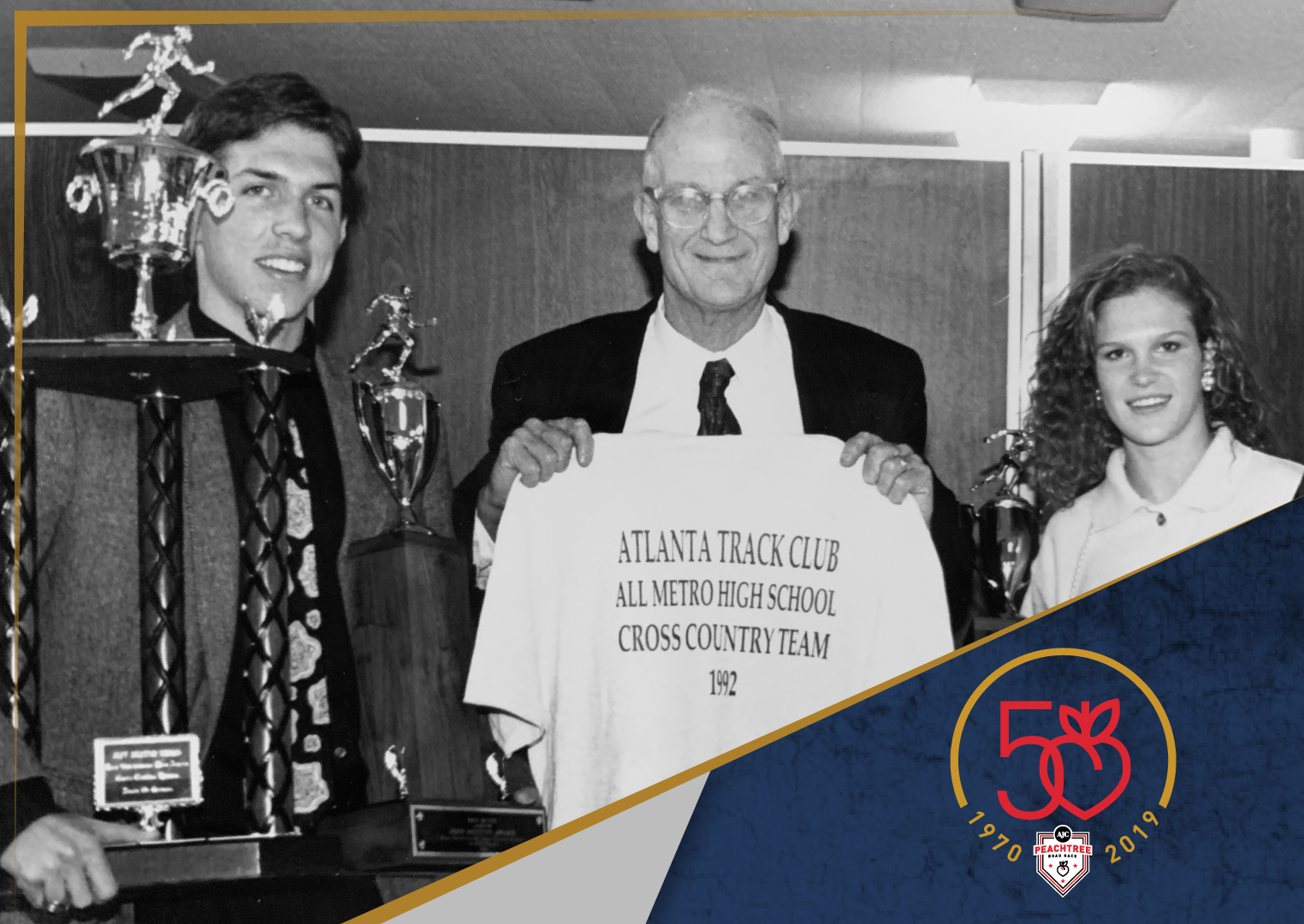Peachtree's Papa

“If I die tonight, I will have accomplished everything I wanted to do: to be a good father to my children and a good husband to my wife.”
– Dr. Tim Singleton, founder of the AJC Peachtree Road Race
The 50th Running of the AJC Peachtree Road Race will be here in a month. After almost a year of articles, you’ve read all about the race, from the people who run in it to the people who support it. But to Tim Singleton, nicknamed “Peachtree’s Papa” by Georgia State University sports commentator Charlie Taylor, before the Peachtree became the largest 10K in the world it was just another race. To Singleton, running and everything else in life was all about balance and doing the right thing for others.
In July of 1969, GSU cross country coach and Dean of Men Tim Singleton drove three of his GSU runners – Billy Bracken, David Mathis and Bruce LaBudde – to the small Fort Benning Medal of Honor race in Fort Benning, Georgia, in his road-worn, blue Volkswagen Microbus. After LaBudde took first place for winning the “6-miler,” they returned with an oversized trophy. The car was cramped, the AC didn’t work, and I-85 was only completed in sections. They had hours to drive until they got home, as did many other runners returning to Georgia. Bracken and Mathis were arguing. As usual, the argument degenerated into a discussion of future races, and Singleton asked, “Why do we have to go way down to Fort Benning when we can have our own Fourth of July race in Atlanta?”
One year later, Singleton, enamored with the Olympics and the metric system, created the Peachtree Road Race 10K, with every inch of it to be run on Peachtree Street. The big draw? Local runners had always wanted to race down the busy Atlanta thoroughfare.
The city issued a parade permit ($25) for the July 4 race because the Braves were playing in San Diego, where they would go on to win 2-1. The race began at 9:30 a.m. to coincide with the Independence Day parade – and because Singleton could get four police officers to work the race for free. Unfortunately, the city rerouted the course due to construction, and the new route would later be determined to fall short of 10K.
The race route started at Sears in Buckhead, ran down Peachtree, turned at Pershing Point onto West Peachtree (different from today’s roads), headed up the enormous hill on Baker Street (later bulldozed), and turned right on Peachtree for five more blocks to the Equitable Life Building with the fountain. “Back in those days, we used to try to make our courses tough,” Singleton would later admit. Jeff Galloway, the winner of the first Peachtree, agreed: “The old Peachtree route was way harder than it is today.”
On race day, Singleton’s family performed their usual roles: His wife, Shelby, supported him by working race registration with Donna Gamel (her husband, Don, and two sons, Chuck (11) and Brian (9) ran in the race). They collected the same-day entry fee of $2 and kept the money in a cigar box. Tim’s sons Greg (7) and Tim Jr. (9) helped at the starting line until the race began, when Shelby drove them to the finish line. There, Greg sat in a lawn chair in the middle of the street holding the finish line string while Tim Jr. worked the “stinky magic marker” and handed runners their finishing order on 3x5-inch index cards for their mother to record. For the Singletons, running and executing a race was part of what families did with their weekends. Everyone had their role, and everyone had fun.
By 9:50, the race was ready to start. It was 80 degrees. No water stops. No course officials. Follow the person in front of you and don’t turn the wrong way. Tim warned the runners through a megaphone, which his sons liked to play with: “Lotta traffic. Ya’ll be careful.”
Forrest “Spec” Towns, a 1936 Olympic gold medalist and world record-holder in the 110-meter hurdles, started the race, and Singleton jumped into the lead car to stay ahead of the runners. By the finish, Jeff Galloway would win the men’s division and Gayle Barron the women’s. It was hot, so Galloway cooled down in the Equitable fountain, and others followed his example. Singleton grabbed a sock full of nickels and another filled with dimes and appointed GSU runner and friend Tommy Raynor as his director of transportation. Raynor’s job was to hand out 15 cents to runners to catch the MARTA bus back to their cars parked at the starting line. In all, 107 men and 3 women – known as the Original 110 – had completed just another Hotlanta race.
The following spring, Tim drove a crew north to compete in the Boston Marathon, where he discovered the significance of the coveted finisher’s T-shirt. As most runners will never win a race, the finisher’s T-shirt becomes their trophy. He brought the idea home, secured a T-shirt design and, for the next five decades, the iconic Peachtree finisher’s T-shirt becomes the trophy for most of its 2 million runners. As 1980 race director Bob Varsha said, “The T-shirt was the key to unlocking our success.”
For the next four years, Singleton continued as race director and secured Carling Brewery as a sponsor. In 1975, he earned his Ph.D. at GSU and accepted a professor of management position at the University of Houston-Clear Lake. Once there, he re-created his Atlanta success, giving even more people a chance to experience the love of running.
* * *
Born in Atlanta on December 22, 1936, Timothy Moore Singleton grew up in a competitive family, thanks partly to his older brother, Gary Jr., but mostly to his father, an aggressive “AAA” baseball player. Tim started running at the age of 5, and by junior high he outpaced his competition. He played summer baseball and worked in a cotton mill in South Carolina, where they took him off the line to play baseball for the mill team. It was during these formative years that Tim began to gravitate toward mentors and leaders, the educated and the inspirational. The lessons he learned would guide him for the rest of his life.
At Druid Hills High School, Tim grew into the athlete all boys wished they could be. At 5 feet, 11 inches and 175 pounds, he excelled in four sports. In football he was a halfback/tailback; in basketball, his “sticky” defense helped the team in back-to-back state championships; in baseball, he led the team in batting; and in track, he captained the team under legendary coach George Muse, who became Tim’s mentor and taught him discipline and precision by knocking bottle caps off hurdles with his shorts as he sailed over them. Tim’s dedication to hard work earned him a state record in the 110-meter hurdles.
Sports, however, were not his only strength, and his high school resume would foreshadow his future. Tim performed in the drama club, sang in the school musical and in his church choir; he was elected class president, won the Librarian Award and the Atlanta Journal Cup for being the best all-around student in his senior class. Singleton attributed his scholastic success to his love of reading, a gift from his mother, Mary.
Once at Georgia Tech, Singleton played tailback for college football hall of famer Bobby Dodd; captained the track team; and in 1959 won the Southeastern AAU hurdle championship. While his first love was always football, knee injuries and concussions sidelined those pursuits. Later, while earning a master’s degree, he discovered a running routine he would follow for much of his life: 11 miles a day for five days a week with a long run on Saturday. GSU recognized Singleton’s influence on others and promoted him to cross-country coach and Dean of Men.
During this time, Tim discovered that there were few organized races for runners after they left college. He joined the Atlanta Striders club and encouraged a merger with the Metro Atlanta Track Coaches Association in the autumn of 1964. Thus did Singleton, along with Hawthorne Wesley, Buddy Fowlkes, John Dunkleberg, Eddie Clack, Ken Winn and Bill Duckworth, form Atlanta Track Club, a place for runners of all abilities to connect and continue racing.
In July 1967, Singleton became Atlanta Track Club’s ’s race director, a position he would hold until 1972 when he formed a race committee that he would chair until his departure in 1975. As a macro-manager, Tim was known to make assignments and then give the committee members autonomy. This led to additional successful races such as the Decatur-DeKalb 4-Miler and the annual Prediction Run. As the Peachtree Road Race became popular, Atlanta Mayor Sam Massell and other local leaders became convinced they could rely on the Club to help Atlanta discover its new identity as a running city.
* * *
Picture this: It’s the late 1960s, and you see a guy running down the street. He’s wearing cut-off football pants over his muscular legs, a sleeveless shirt and a train conductor’s hat. If it’s cold, he’s wearing garden gloves. If he sees you running, he comes over and introduces himself.
“He was a runner with a happy vibe, and people wanted to be around him” Tim Singleton, Jr., said of his father.
As Singleton grew older, he realized he could no longer compete with younger runners. To compensate, he created new race categories. “Fountain of Youth” for runners over 30. “Clydesdale” for runners over 250 pounds. Every race Singleton designed was meant to challenge runners of all ages and abilities and to encourage love of the sport. To him, the Peachtree Road Race was never about the number of participants, prizes or even the legendary T-shirt. To Singleton, all of the races he created were for the people who ran them.
In 2015, Atlanta Track Club named its large conference room the Singleton Room.
Singleton’s success at the University of Houston-Clear Lake led to his eventual homecoming as professor of business and Lee Anderson Chair of Business Management at North Georgia College in Dahlonega, Georgia, where he and his wife, Martha, retired. It was only then that Tim slowed down, though he continued to sing with his church choir.
Singleton died July 31, 2013. His legacy lives on in every hot, hilly and humid Atlanta road race.
“Before Tim left for Houston, he told us that no one person could achieve what all of us could achieve together, but we disagreed. Tim did it all. Tim was the heart and soul of the Atlanta Track Club, and the Atlanta Track Club was Tim Singleton.”
- Hawthorne Wesley, ATC founding father
Terry Banker is a freelance writer and a former member of Atlanta Track Club’s history committee. The committee’s charge was to compile the history of the organization by collecting the stories of those who were there during the formation of Atlanta Track Club and its growth in the 1970s and 80s. This account of Tim Singleton, founder of the AJC Peachtree Road Race, comes from extensive interviews with the Original 110 finishers and those who worked with Singleton to organize the race. Jack McFarland, a member of the Original 110, assisted in the research about his late friend and fellow runner.







